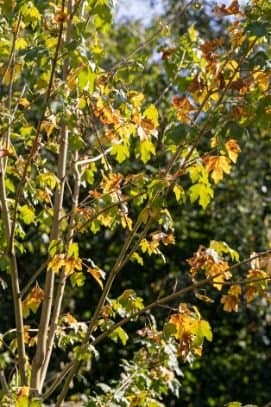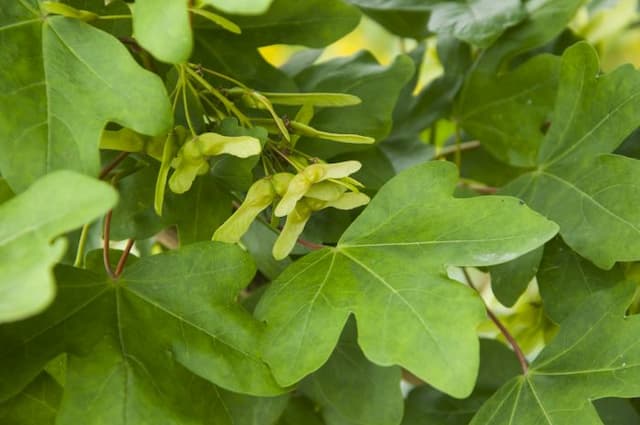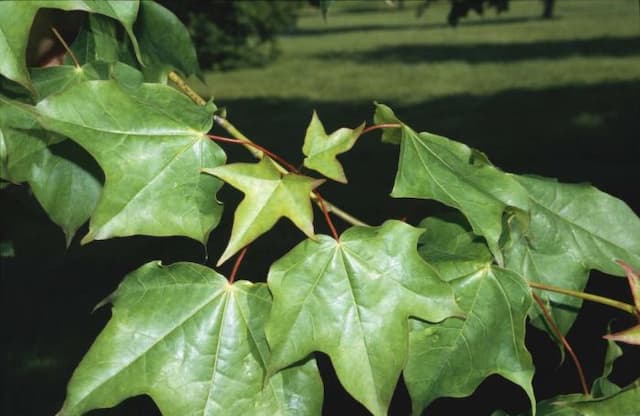Silver Vein Maple Acer × conspicuum 'Silver Vein'

ABOUT
The Acer × conspicuum 'Silver Vein', commonly known as the Silver Vein Maple, is distinguished by its striking ornamental features. It boasts a bark that peels away in patches to reveal a white and pale green underbark that creates a beautiful, contrasting mosaic effect. This decorative bark is one of its most prominent characteristics, offering year-round visual interest even in winter when the leaves have fallen. The leaves of the Silver Vein Maple are equally appealing with their distinct shape and coloration. They emerge with a pinkish hue in spring, maturing to a green color with silver veins running through them, which is where the plant gets its common name. Come autumn, the foliage transforms again, putting on a show of colors ranging from yellow to orange and even red, providing a splendid display before leaf drop. The plant's overall structure tends to be multi-stemmed, with branches spreading outwards to create an elegant, rounded canopy. This gives it a graceful silhouette that can complement many garden designs. As a deciduous tree, it will shed its leaves annually, but the changing seasons bring about an evolving beauty that makes the Silver Vein Maple a dynamic and visually appealing choice for gardeners and landscape enthusiasts.
About this plant
 Names
NamesFamily
Sapindaceae
Synonyms
Silver Vein Maple
Common names
Acer × conspicuum 'Silver Vein'.
 Toxicity
ToxicityTo humans
The Acer × conspicuum 'Silver Vein', commonly known as Silver Vein Maple, is not known to be toxic to humans. There are no common reports of poisoning or severe adverse effects associated with ingestion of this plant by humans. Therefore, incidental contact or ingestion of the leaves, seeds, or bark of this maple tree is unlikely to cause harm, but as with any plant, overconsumption or individual sensitivities could potentially cause mild gastrointestinal discomfort.
To pets
Silver Vein Maple is not widely recognized as a toxic plant to pets. There is limited information on specific toxicity for this hybrid maple, but in general, maples in the Acer genus are not typically associated with severe toxicity in pets. However, it is always best to prevent pets from ingesting plants, as individual sensitivities can vary, and some maples can cause issues such as gastrointestinal upset. If a pet shows signs of illness after ingesting any part of the plant, it is prudent to consult a veterinarian.
 Characteristics
CharacteristicsLife cycle
Perennials
Foliage type
Deciduous
Color of leaves
Variegated
Flower color
Yellow
Height
20-30 feet (6-9 meters)
Spread
15-20 feet (4.5-6 meters)
Plant type
Tree
Hardiness zones
6
Native area
Asia
Benefits
 General Benefits
General Benefits- Ornamental Appeal: Adds visual interest to gardens with its striking silver-veined foliage and attractive bark.
- Seasonal Interest: Offers year-round beauty with changing leaf colors and winter bark texture.
- Wildlife Habitat: Provides shelter and food opportunities for birds and beneficial insects.
- Shade Provider: Creates areas of shade in gardens that can help in cooling surrounding spaces and providing shelter for understory plants.
- Drought Tolerance: Once established, it can be more resistant to periods of drought, requiring less frequent watering.
- Low Maintenance: Typically requires minimal pruning or additional care once established in an appropriate environment.
- Urban Tolerant: Can be suitable for urban environments, tolerating pollution and confined soil spaces.
- Erosion Control: Helps stabilize soil with its root system, preventing erosion in certain landscapes.
 Medical Properties
Medical PropertiesThis plant is not used for medical purposes.
 Air-purifying Qualities
Air-purifying QualitiesThis plant is not specifically known for air purifying qualities.
 Other Uses
Other Uses- The Silver Vein Maple's branches and twigs can be used in floral arrangements due to their distinctive colors and patterns, adding an elegant touch to bouquets and indoor decor.
- Wood from the Silver Vein Maple is sometimes harvested for woodworking projects as it can offer unique grain patterns, suitable for crafting jewelry boxes, picture frames, and other fine wood items.
- The tree can serve as a host for various species of moss and lichen, which can be encouraged for a natural garden aesthetic or for studying these organisms.
- In bonsai cultivation, the Silver Vein Maple might be used for its decorative bark and foliage, offering a different variety for enthusiasts to shape and display.
- Dried leaves of the Silver Vein Maple can be incorporated into handmade paper, providing a decorative element with their intricate vein patterns.
- Sap collected from the Silver Vein Maple, similar to that of other maples, can sometimes be used in small-scale production of syrups or sugars, though it's not as common as with the Sugar Maple.
- The tree's fall foliage can be collected and used as a natural dye in textiles, where the leaves' colors can impart subtle hues to fabrics.
- Photographers and artists may utilize the Silver Vein Maple as a subject or backdrop in their work due to its striking appearance across seasons.
- The bark's unique texture can be used in casting projects to create interesting patterns in plaster or other moldable materials.
- During festive seasons, the branches of the Silver Vein Maple can be cut and used as natural decor, either on their own or painted, for events and holidays.
Interesting Facts
 Feng Shui
Feng ShuiThe Snakebark Maple is not used in Feng Shui practice.
 Zodiac Sign Compitability
Zodiac Sign CompitabilityThe Snakebark Maple is not used in astrology practice.
 Plant Symbolism
Plant Symbolism- Strength and Endurance: Acer, commonly known as Maple, generally symbolizes strength and endurance due to its hardy nature and the ability to withstand cold climates.
- Wisdom: Maples are often associated with wisdom, as they are long-lived trees, gaining knowledge from their enduring presence over time.
- Balance: The Maple tree's distinct leaves, especially the balance in its symmetrical leaf structure, can represent the idea of balance, reflecting how one can live a balanced life.
- Beauty and Uniqueness: 'Silver Vein', with its striking silver-veined leaves, highlights the beauty and uniqueness present in nature, symbolizing the value of embracing one's own individuality.
 Water
WaterStripebark Maple prefers consistently moist soil, so it should be watered thoroughly whenever the top inch of soil feels dry to the touch. Depending on the weather and soil conditions, this could be once every week or two. Use a soaker hose or drip irrigation to provide a deep watering that reaches the root zone, using about 2 gallons of water each time for a young tree. During hot, dry periods, the frequency may increase, and in cooler, wetter conditions, it may decrease. It is important to avoid waterlogging the soil as this can lead to root rot.
 Light
LightStripebark Maple thrives in a spot with full sun to partial shade, so aim for a location where it receives at least four hours of direct sunlight daily, but is protected from the harshest midday rays. Dappled sunlight under the canopy of taller trees is also suitable for this tree, making it a flexible choice for many garden designs.
 Temperature
TemperatureStripebark Maple does well in a range of temperatures but is best suited to USDA hardiness zones 5 through 8. The tree can survive winter lows down to -20°F and summer highs up to 90°F, but it performs best in areas where the average temperature ranges between 60°F and 75°F.
 Pruning
PruningStripebark Maple benefits from pruning to remove dead or damaged branches, improve airflow, and maintain an attractive shape. The best time to prune is late winter or early spring before new growth begins. Pruning should be done sparingly, focusing on crossing branches or any that disrupt the tree’s structure. It's usually not necessary to prune every year, but inspect the tree annually to determine if pruning is needed.
 Cleaning
CleaningAs needed
 Soil
SoilThe Silver Vein Maple flourishes in well-draining, moist soil that is rich in organic matter. A mix of loam, peat, and sand in equal parts is ideal. The soil pH should be slightly acidic to neutral, ranging from 5.5 to 7.5.
 Repotting
RepottingSilver Vein Maples are slow-growing and don't require frequent repotting. You should repot these trees approximately every 2-3 years to prevent the roots from becoming pot-bound and to replenish the soil.
 Humidity & Misting
Humidity & MistingSilver Vein Maple prefers moderate to high humidity levels, ideally between 50% to 70%, to mimic its natural environment and promote healthy growth.
 Suitable locations
Suitable locationsIndoor
Place Silver Vein Maple near bright, filtered light, away from drafts.
Outdoor
Plant in partial shade, protect from strong winds, water deeply.
 Life cycle
Life cycleThe Acer × conspicuum 'Silver Vein', commonly known as Silver Vein Maple, begins its life cycle with seed germination, typically in spring when the soil is moist and temperatures are moderate. After germination, the seedling emerges and develops into a young plant through the vegetative growth stage, where it produces leaves, stems, and roots. As the Silver Vein Maple matures, it enters the reproductive stage, developing flowers that are pollinated by wind or insects, leading to the formation of winged fruits called samaras. These samaras disperse from the parent plant, usually by wind, to colonize new areas where they can germinate given suitable conditions. The tree continues to grow in size and may go through cycles of flowering and fruiting annually, depending on environmental conditions. Finally, after a lifespan that can extend several decades, the tree will eventually senesce and die, completing its life cycle.
 Propogation
PropogationPropogation time
Spring to Summer
The most popular method of propagating the Acer × conspicuum 'Silver Vein', commonly known as the Silver Vein Maple, is by grafting. This technique is generally undertaken during the late winter or early spring, just before the growing season begins. Grafting involves taking a scion, which is a small cutting with several buds, from the Silver Vein Maple and attaching it to the rootstock of another maple species. The cut on both the scion and the rootstock must be made to match and fit tightly together, usually in a sloping or wedge-shaped manner. The joint is then wrapped securely to maintain alignment and moisture, and sealed with grafting tape or wax to prevent drying out. Over time, the scion and rootstock will fuse together, creating a new Silver Vein Maple tree that combines the characteristics of the parent tree's attractive foliage with the robustness of the rootstock.






![Freeman maple [Autumn Blaze]](/_next/image?url=https%3A%2F%2Fplants-admin.emdemapps.com%2Fimages%2Fplants%2F%2Fimages%2F604b575b84d87.png&w=640&q=75)


